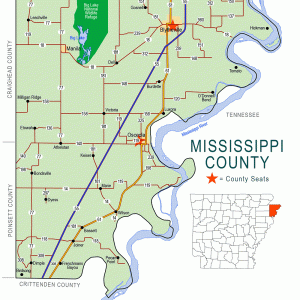calsfoundation@cals.org
Bassett (Mississippi County)
| Latitude and Longitude: | 35°32’11″N 090°07’36″W |
| Elevation: | 236 feet |
| Area: | 0.24 square miles (2020 Census) |
| Population: | 124 (2020 Census) |
| Incorporation Date: | November 26, 1965 |
Historical Population as per the U.S. Census:
|
1810 |
1820 |
1830 |
1840 |
1850 |
1860 |
1870 |
1880 |
1890 |
1900 |
|
– |
– |
– |
– |
– |
– |
– |
– |
– |
– |
|
1910 |
1920 |
1930 |
1940 |
1950 |
1960 |
1970 |
1980 |
1990 |
2000 |
|
– |
– |
– |
– |
– |
– |
265 |
243 |
199 |
168 |
|
2010 |
2020 |
|
|
|
|
|
|
|
|
|
173 |
124 |
|
|
|
|
|
|
|
|
The town of Bassett is located on Highway 61 in southern Mississippi County. It is about halfway between Wilson (Mississippi County) and Joiner (Mississippi County).
Bassett sits on higher ground that, for most of recorded history, was surrounded by swampland and hardwood forests. Artifacts unearthed in the area indicate that the knoll has been inhabited for many centuries. Mississippi County historian Mabel Edrington wrote in 1962 that a 100-acre Native American cemetery had existed at the site. Several Indian nations have been associated with northeastern Arkansas, but over time, they all signed treaties with the federal government and moved west to Indian Territory, now the state of Oklahoma.
The first construction in Bassett that was not done by Indians is also a cemetery. The oldest markers in the cemetery were placed in 1868. It is uncertain why it is known as Bassett Cemetery, since no one with that surname is known to be buried in the cemetery, and the name does not appear in early census records of the county. Nevertheless, a small settlement also known as Bassett grew just north of the cemetery.
In 1880, fifteen-year-old Robert E. Lee Wilson worked as a wage laborer on a plantation near Bassett. He had inherited 400 acres from his father a few years before, but the land was difficult to farm due to swamps and forests. While working near Bassett, Wilson developed a plan to drain the swamps, harvest the trees, and create large productive fields of cotton, profiting from all stages of the development. In 1885, he purchased a sawmill and began enacting his plan; by the time he died, Wilson owned more than 65,000 acres of rich farmland that employed most of the workers in that part of the county. His business, Lee Wilson & Company, also operated a railroad and several company stores that met the needs of his workers. Wilson and his company created five new towns in Mississippi County, including Wilson a few miles northeast of Bassett. Although the company did not create the town of Bassett, it operated a large company store in the community.
In 1903, the St. Louis–San Francisco Railway (the “Frisco”) planned a rail line that ran through Mississippi County. Although the line ran past Bassett, evidently a depot was never planned for the community, since the promised depot at Joiner was not much farther down the line. Even so, a post office opened in Bassett in 1904.
During the 1930s, U.S. Highway 61 was built, connecting the state of Minnesota with New Orleans, Louisiana, on a route that follows the Mississippi River. In Bassett, the highway runs parallel to the railroad tracks, separating the community from the tracks. Highway 61 would later be designated the Blues Highway for the music that was developing in the twentieth century in cities, towns, and rural areas near the highway. Highway 61 in Bassett is also part of the Great River Road, which draws tourists through scenic areas on both sides of the Mississippi River.
During World War II, a branch camp for prisoners of war (POWs) was established near Bassett. The POWs, many of them from Germany’s Afrika Corps, worked in the cotton fields, replacing American men who had gone to war.
Interstate 55 was extended from St. Louis, Missouri, to Memphis, Tennessee, and beyond in the late 1960s and early 1970s. Bassett is several miles east of the interstate, but state Highway 181 connects the town with I-55.
Although the community had remained unincorporated for about a century, the residents of Bassett decided to seek incorporation as a town in 1965 so they could raise money—both local taxes and matching funds from state and federal programs—to pave streets, provide water and sewer service, and offer other benefits of incorporated status. Even so, the population of Bassett dwindled from 265 to 168 between 1970 and 2000. It rose to 173 by the 2010 census; 156 were listed as white, fourteen as African American, and three as Hispanic. Children in Bassett attend school in Wilson. Bassett Presbyterian Church has served the town for many years, and the town has a store and gas station.
For additional information:
Edrington, Mabel F. History of Mississippi County, Arkansas, 1962. Ocala, FL: Ocala Star-Banner, 1962.
Goble, L. Irene Dallas. Bassett Cemetery, Old Section, Mississippi County, Arkansas. Bassett, AR: 2003.
Steven Teske
Butler Center for Arkansas Studies
 Mississippi County Map
Mississippi County Map 




I’m so glad you have a little history about Bassett. My father was raised in this town, and my grandfather W. C. LaRue Jr. got the town incorporated. My family has attended Bassett Presbyterian Church for over fifty years.